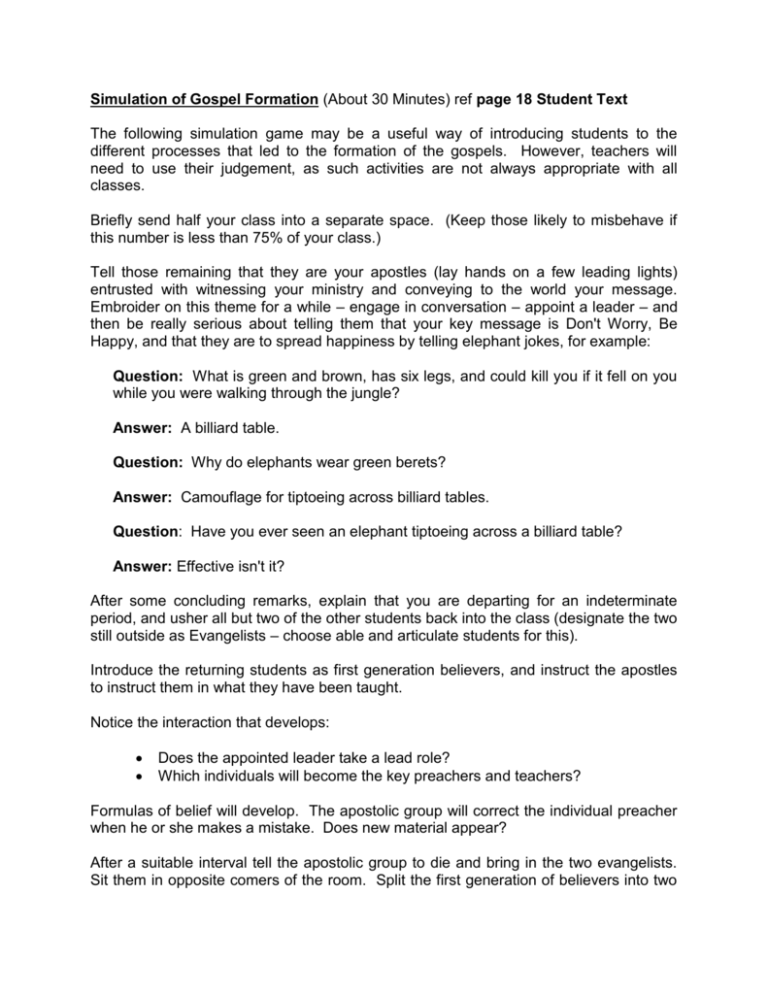Simulation of Gospel Formation
advertisement

Simulation of Gospel Formation (About 30 Minutes) ref page 18 Student Text The following simulation game may be a useful way of introducing students to the different processes that led to the formation of the gospels. However, teachers will need to use their judgement, as such activities are not always appropriate with all classes. Briefly send half your class into a separate space. (Keep those likely to misbehave if this number is less than 75% of your class.) Tell those remaining that they are your apostles (lay hands on a few leading lights) entrusted with witnessing your ministry and conveying to the world your message. Embroider on this theme for a while – engage in conversation – appoint a leader – and then be really serious about telling them that your key message is Don't Worry, Be Happy, and that they are to spread happiness by telling elephant jokes, for example: Question: What is green and brown, has six legs, and could kill you if it fell on you while you were walking through the jungle? Answer: A billiard table. Question: Why do elephants wear green berets? Answer: Camouflage for tiptoeing across billiard tables. Question: Have you ever seen an elephant tiptoeing across a billiard table? Answer: Effective isn't it? After some concluding remarks, explain that you are departing for an indeterminate period, and usher all but two of the other students back into the class (designate the two still outside as Evangelists – choose able and articulate students for this). Introduce the returning students as first generation believers, and instruct the apostles to instruct them in what they have been taught. Notice the interaction that develops: Does the appointed leader take a lead role? Which individuals will become the key preachers and teachers? Formulas of belief will develop. The apostolic group will correct the individual preacher when he or she makes a mistake. Does new material appear? After a suitable interval tell the apostolic group to die and bring in the two evangelists. Sit them in opposite comers of the room. Split the first generation of believers into two and assign each group to an evangelist. The evangelist is to write a piece communicating the message conveyed to them by their group of believers. Notice: Do the writers write down everything said to them? How do they pick and choose? Do both writers get the same story? How and why do they differ? Bring the activity to a stop. Bring the apostles back to life, and collect the two written accounts. Read them to the class – ask the apostolic group to comment on their accuracy. Almost always the accounts will have the jokes reasonably accurate. (Billiard table frequently becomes pool table, an example of images from one culture being translated into another.) The elephant jokes will be told in a different order, as the Gospels are in terms of the narrative. Ask the question: The jokes I told were the part best transmitted. What aspects of the teaching of Jesus would have been transmitted like jokes? (Answer: Parables and stories.) Tell the class what you had noticed during the oral transmission: The credal statements – parts of the message that became standardised formulae. The checks and balances – the roles of leaders and the way the group corrects individual errors. Refer students to The Three Stages of Gospel Formation in Student Text on page 13. Speak to this material relating it to the simulation exercise just done. Draw their attention to the different processes going on: eg witnessing something is different from telling a story about it. Telling a story is different from writing down the story. Why do elephants paint the soles of their feet yellow? So they can hide upside-down in the custard. How do you know when an elephant has been in your fridge? Some More Elephant Jokes What time is it when an elephant sits on your fence? Time to get a new fence. Why are elephants large, grey and wrinkled? Have you ever tried ironing one? What's grey, has four legs, and a trunk? A mouse, going on holiday. What's brown, has four legs, and a trunk? The same mouse, coming back from holiday. Why do elephants paint themselves green? So they can sneak across snooker tables without being seen. How do elephants get up trees? They sit on an acorn and fall asleep. How do elephants get down from trees? They sit on a leaf and wait for autumn. Why are crocodiles long, thin and flat? They walk under trees in autumn. How do you fit four elephants into a Mini? Two in the front, two in the back. How do you know when an elephant is visiting your house? There's a Mini outside with three elephants in it. How do you get an elephant into a matchbox? Take out all the matches first.










